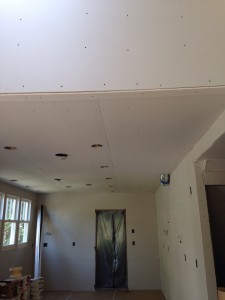 Let us begin with the standard eight-foot sheet of drywall. Most of the drywall contractors prefer to apply drywall horizontally. Nevertheless, I have seen contractors that work with metal stud frames installing 10-foot sheets of drywall vertically.
Let us begin with the standard eight-foot sheet of drywall. Most of the drywall contractors prefer to apply drywall horizontally. Nevertheless, I have seen contractors that work with metal stud frames installing 10-foot sheets of drywall vertically.
The motives for installing the vertical installation of the 10-foot sheets of drywall vertically or up and down in this case are very simple. No structural strength is needed in such walls since they are just partitions that divide rooms and normally the drywall only needs to be finished up to 9 feet. It is the only time I have seen someone run drywall vertically.
In wood framed houses, drywall essentially adds a little sheer value to the homes themselves.
The manufacturer recommends horizontal installation of the 8-foot sheets of drywall. Horizontal installation of drywall means installing the 8-foot side of the drywall side to side and the 4-foot side of the drywall up and down.
What is the reason for horizontal installation of the 4 x 8 sheets?
Concerning finishing the drywall, the 4-foot seams running either vertically or up and down will not be as noticeable as those running up and down the entire wall. In case you have not read one of my previous articles on eye level window setting then let me give you brief schooling on eye level.
An individual 5’8” in height will be more likely to notice things between 4’6” and 6’6” off the ground. If we ran drywall vertically, there is a higher likelihood of the eyes being able to pick up any flaws in the finishing of the drywall. Horizontal running of the drywall simply puts us slightly out of range from the lower eye level of 4’6” with our finish.
Another justification for the horizontal installation of the drywall is that there is a good chance that your eyes would be able to pick up 4-foot lines in the wall running from ceiling to floor rather easily. In older houses, the lines in the ceilings are quite visible around every 24 inches. The reason for this being that the drywall or plaster ceiling is starting to sag in between the ceiling joint.
Once the drywall is finished, you can do nothing much about these lines. The only viable option you would have is to remove the ceiling, re-drywall it, and then finish it.
Vertically run drywall tends to crack much easier than the staggered and horizontally ran drywall. The 4-foot portion of drywall is much stronger than the Eight-foot portion. By staggering the drywall breaks every 4-feet, you will be increasing your wall’s strength as well.
Avoid breaking the drywall at any door openings. Door openings tend to crack easily from the corners working their way up towards the ceiling. Allow the drywall to run over the doorway and then cut the doorway out and leave the rough door opening when installing the wallboard.
If you have ever viewed a house that a professional crew has drywalled the waste is simply unbelievable. The reason being that the drywall contractor does not fancy coming back to patch up the cracks in the walls 3 or 4 years after the work is done. It can be quite a labor-intensive process to install scrap pieces of drywall when compared to using larger sheets to cover the same area.
Always remember and never forget that. The manufacturer always recommends horizontal installation of the drywall.
